Do you have a question about the Hisense AVW-38UCSC and is the answer not in the manual?
Explains DANGER, WARNING, CAUTION, and NOTE signal words for hazard identification.
Instructions on how to dispose of the product responsibly to prevent environmental harm.
Details critical safety measures and potential hazards related to refrigerant and electrical safety.
Covers installation cautions, appliance use by vulnerable persons, and general operating notes.
Guidelines for inspecting the product upon receipt for shipping damage and verifying specifications.
Identifies and lists the components of the outdoor unit with a diagram.
Illustrates the refrigerant flow and key components within the system.
Lists required tools and instruments for installation, noting compatibility with refrigerants.
Details how to match indoor and outdoor units and safe methods for transporting the unit.
Lists included accessories and outlines initial site checks before installation.
Specifies required service space and procedures for securing the outdoor unit with anchor bolts.
Details requirements for copper piping, sizing, and cleaning to prevent contamination.
Provides dimensions for flaring, pipe thickness, and flare nut sizes for R410A.
Specifies pipe size limitations and how to calculate additional refrigerant charge.
Details system pipe lengths and additional refrigerant quantity calculation for various configurations.
Provides dimensions and specifications for T-shape branch pipes used in the system.
Details how to connect pipes from different directions and remove service covers.
Outlines the steps for performing an air-tight test on the refrigerant piping system.
Explains the process of vacuum pumping and charging the refrigerant into the system.
Covers proper refrigerant handling, purging, and concentration safety measures.
Details how to use check joints to measure pressure during different operation modes.
Guides on calculating additional refrigerant, charging, and recording the process.
Procedures for collecting refrigerant and essential safety precautions for electrical work.
Covers checks for power supply, wiring, grounding, and electrical resistance.
Details how to connect power supply and control communication cables between units.
Explains how to set dip-switches for communication and terminal resistors in Hi-NET systems.
Lists essential checks before test run and critical warnings during operation.
Details the high-pressure switch settings and fuses for compressor protection.
Lists technical specifications for cooling and heating performance, efficiency, and loads.
Provides basic product details, refrigerant information, and its environmental impact.
Explains DANGER, WARNING, CAUTION, and NOTE signal words for hazard identification.
Instructions on how to dispose of the product responsibly to prevent environmental harm.
Details critical safety measures and potential hazards related to refrigerant and electrical safety.
Covers installation cautions, appliance use by vulnerable persons, and general operating notes.
Guidelines for inspecting the product upon receipt for shipping damage and verifying specifications.
Identifies and lists the components of the outdoor unit with a diagram.
Illustrates the refrigerant flow and key components within the system.
Lists required tools and instruments for installation, noting compatibility with refrigerants.
Details how to match indoor and outdoor units and safe methods for transporting the unit.
Lists included accessories and outlines initial site checks before installation.
Specifies required service space and procedures for securing the outdoor unit with anchor bolts.
Details requirements for copper piping, sizing, and cleaning to prevent contamination.
Provides dimensions for flaring, pipe thickness, and flare nut sizes for R410A.
Specifies pipe size limitations and how to calculate additional refrigerant charge.
Details system pipe lengths and additional refrigerant quantity calculation for various configurations.
Provides dimensions and specifications for T-shape branch pipes used in the system.
Details how to connect pipes from different directions and remove service covers.
Outlines the steps for performing an air-tight test on the refrigerant piping system.
Explains the process of vacuum pumping and charging the refrigerant into the system.
Covers proper refrigerant handling, purging, and concentration safety measures.
Details how to use check joints to measure pressure during different operation modes.
Guides on calculating additional refrigerant, charging, and recording the process.
Procedures for collecting refrigerant and essential safety precautions for electrical work.
Covers checks for power supply, wiring, grounding, and electrical resistance.
Details how to connect power supply and control communication cables between units.
Explains how to set dip-switches for communication and terminal resistors in Hi-NET systems.
Lists essential checks before test run and critical warnings during operation.
Details the high-pressure switch settings and fuses for compressor protection.
Lists technical specifications for cooling and heating performance, efficiency, and loads.
Provides basic product details, refrigerant information, and its environmental impact.
| Brand | Hisense |
|---|---|
| Model | AVW-38UCSC |
| Category | Air Conditioner |
| Language | English |
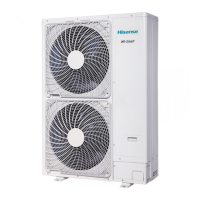
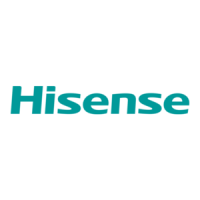





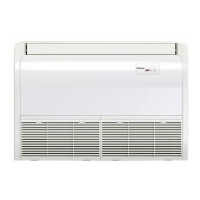
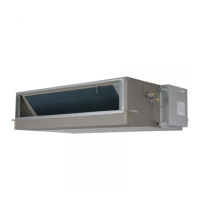

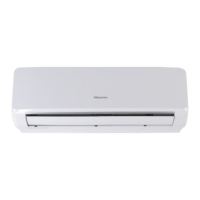
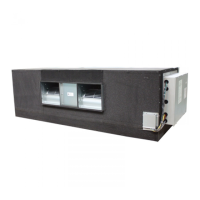
